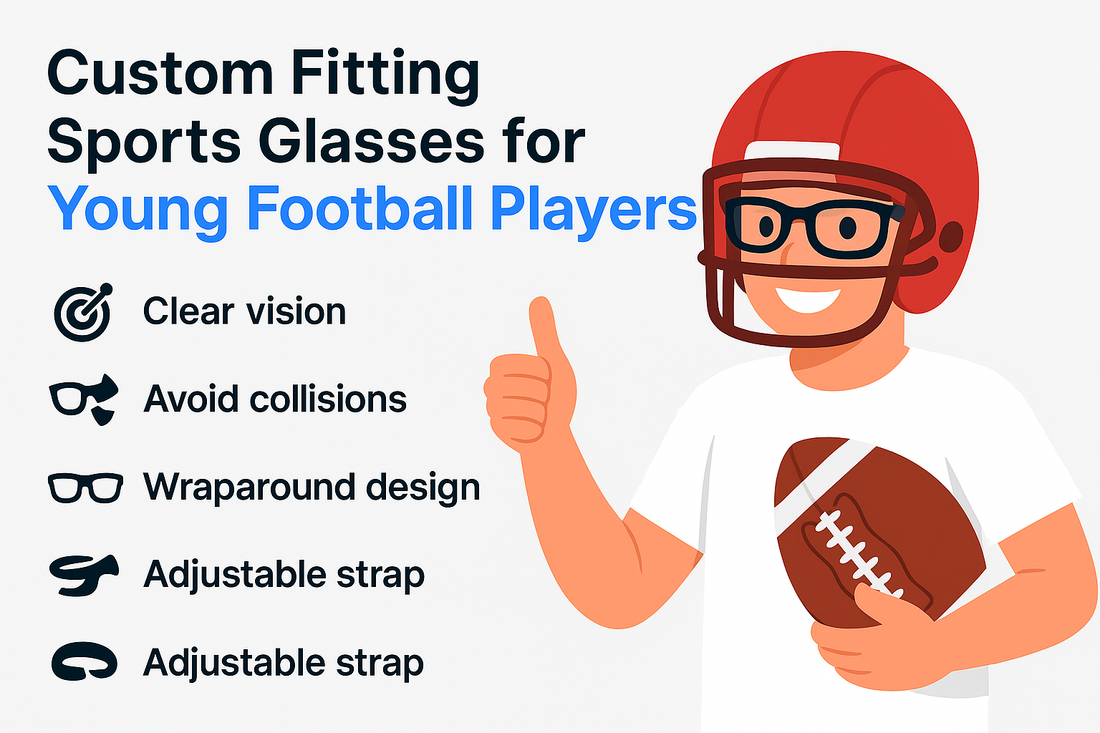
Custom Fitting Sports Glasses for Young Football Players
Clear vision and reliable eye protection can change the way a young athlete plays. For youth football, custom fitting sports glasses helps kids track the ball, avoid collisions, and stay comfortable every snap 🏈. Here is how to dial in a fit that is safe, secure, and helmet ready.
Why the right fit matters
Football is fast, physical, and often played in changing light and weather. Glasses that slip, fog, or pinch can distract a player and impact performance. A proper fit keeps frames stable during sprints and tackles, positions lenses for crisp vision, and protects the eyes from impact or debris. The goal is simple: see better, play better, stay safer.
Key fitting zones to get right
- Bridge and nose pads: The frame should rest evenly on the nose without sliding when your child shakes their head. Soft, grippy pads improve comfort and stability 👓.
- Temple length and curve: Temples should follow the ear line without pressing. Ends can be adjusted slightly to hug the head for a secure, gentle hold.
- Frame width: The front should be as wide as the face, with temples entering straight. If temples flare outward, the frame is too narrow; if they pinch inward, it is too wide.
- Strap support: For youth football, a robust, adjustable strap keeps eyewear in place under a helmet. Check that the strap sits flat and does not twist.
Lens materials and coatings that work hard
Choose impact-resistant lenses such as polycarbonate or Trivex for dependable protection. Add an anti-fog coating to tame steamy timeouts and a scratch-resistant layer for daily durability. Light tints or photochromic options can help with glare on bright fields, though many players prefer clear lenses for consistent color perception.
How to measure at home
- Pupillary distance (PD): With your child looking straight ahead, measure the distance between the centers of the pupils using a millimeter ruler. Accurate PD centers the optics for sharp vision.
- Temple length: Measure from the hinge to just past the ear where the temple will rest. A good fit reduces bounce and hot spots.
- Bridge fit check: Place a sample frame or current pair on the nose. If it slides with a gentle nod, look for adjustable pads or a smaller bridge.
Make it helmet compatible
Bring the football helmet into the fitting whenever possible. Put the glasses on first, then the helmet. The frame should not touch the shell or interior padding, and the strap should sit beneath the helmet padding without digging. Ask your child to run in place, look side to side, and simulate catching to confirm stability ✅.
Comfort and performance tweaks
- Grip upgrades: Silicone temple tips and textured nose pads improve hold without extra pressure.
- Strap tension: Tighten until movement stops, then back off slightly for comfort. Recheck after a few practices.
- Fog control: Combine anti-fog coating with a microfiber wipe and quick airflow breaks on the sideline. Keep frames clean to reduce moisture buildup.
Prescription and vision clarity
If your player needs a prescription, size the frame correctly before lenses are cut. Center the optical zone on the child’s PD and align lens height with the natural gaze while wearing the helmet. After pickup, have your child read field markers and track a ball to verify clarity and peripheral awareness.
Care that keeps glasses game ready
- Rinse dust and turf from lenses before wiping to avoid scratches.
- Use a hard case in the gear bag to prevent sideline damage.
- Do a quick fit check before each practice. Kids grow fast, so straps and pads may need adjustments 💡.
Common signs the fit needs work
- Red marks on the nose or behind ears after practice.
- Frequent adjusting, slipping, or bouncing during runs.
- Persistent fogging that doesn’t improve with cleaning or anti-fog.
- Helmet pressure points or difficulty putting the helmet on.
Looking for the right eyewear? Here are our top picks based on today’s article:
- Steph Kids Sports Glasses in Black and Blue
- Winner Kids Sports Glasses in Black
- Lebron Kids (White W/Blue Mirror Sunglasses)
FAQs
How tight should my child’s sports glasses feel under a football helmet?
They should feel secure without pressure points. If you see red marks or your child complains, loosen the strap slightly or adjust the pads.
What lens material is best for young football players?
Polycarbonate or Trivex lenses are ideal because they are impact resistant, light, and provide crisp optics for fast play.
Can I stop fogging without replacing the lenses?
Often yes. Use anti-fog wipes, keep lenses clean, and ensure proper strap tension so warm air can ventilate.



